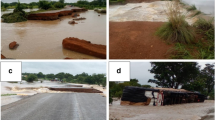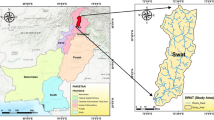Abstract
Landslide susceptibility map delineates the potential zones for landslides occurrence. The paper presents a statistical approach through spatial data analysis in GIS for landslide susceptibility mapping in parts of Sikkim Himalaya. Six important causative factors for landslide occurrences were selected and corresponding thematic data layers were prepared in GIS. Topographic maps, satellite image, field data and published maps constitute the input data for thematic layer preparation. Numerical weights for different categories of these factors were determined based on a statistical approach and the weighted thematic layers were integrated in GIS environment to generate the landslide susceptibility map of the area. The landslide susceptibility map classifies the area into five different landslide susceptible zones i.e., very high, high, moderate, low and very low. This map was validated using the existing landslide distribution in the area.
Similar content being viewed by others
References
Anbalagan R. 1992. Landslide hazard evaluation and zonation mapping in mountainous terrain. Engineering Geology, 32:269–277.
Bhasin R., Grimstad E., Larsen J. O., Dhawan A. K., Singh R, Verma S. K. and Venkatachalam K. 2002. Landslide hazards and mitigation measures at Gangtok, Sikkim Himalaya. Engg. Geology, 64:351–368.
Carrara A. 1983. Multivariate models for landslide hazard evaluation. Mathematical Geology, 15(3):403–427.
Carrara A., Cardinali M., Detti F., Guzzetti F., Pasqui V. and Reichenbach P. 1991. GIStechniques and statistical models in evaluating landslide hazard. Earth Surface Processes and Landforms, 16(5):427–445.
Chung C. F. and Fabbri A. G. 1999. Probabilistic Prediction Models for Landslide Hazard Mapping, Photogrammetric Engineering & Remote Sensing, 65(12), 1389–1399.
Chung C. F., Fabbri A. G. and van Westen C. J. 1995. Multivariate regression analysis for landslide hazard zonation. Geographical Information Systems in Assessing Natural Hazards (A. Carrara, and F. Guzzetti, editors), Kluwer Academic Publishers, Dordrecht, pp.107–134.
Dhakal A. S., Amada T. and Aniya M. 2000. Landslide hazard mapping and its evaluation using GIS: An investigation of sampling schemes for a grid-cell based quantitative method. Photogrammetric Engg. & Remote Sensing, 66(8):981–989.
Gupta R. P. and Joshi B. C. 1990. Landslide hazard zoning using the GIS approach — A case study from Ramganga catchment, Himalaya. Engg. Geol, 28:119–131.
Jade S. and Sarkar S. 1993. Statistical model for slope instability classifications. Engineering Geology, 36:71–98.
Juang C. H., Lee D. H. and Sheu C. 1992. Mapping slope failure potential using fuzzy sets. Geotechnical Engineering, 118(3):475–494.
Kanungo D. P., Arora M. K., Sarkar S. and Gupta R. P. 2006. A comparative study of conventional, ANN black box, fuzzy and combined neural and fuzzy weighting procedures for landslide susceptibility zonation in Darjeeling Himalayas. Engineering Geology, Vol. 85, pp. 347–366.
Kingsbury P. A., Hastie W. J. and Harrington A. J. 1992. Regional landslip hazard assessment using a GIS. Proceedings of the 6 th International Symposium on Landslides, Christchurc. 2:995–1000.
Lee S., Choi J. and Min K. D. 2002b. Landslide Susceptibility Analysis and Verification using the Bayesian Probability Model, Environmental Geology, 43, 120–131.
Lin, M-L. and Tung, C-C. 2003. A GIS-based Potential Analysis of the Landslides induced by the Chi-Chi Earthquake, Engineering Geology, 71, 63–77.
Lu P. F. and An P. 1999. A Metric for Spatial Data Layers in Favorability Mapping for Geological Events, IEEE Transaction on Geosciences & Remote Sensing, 37, 1194–1198.
Nagarajan R., Mukherjee A., Roy A. and Khire M. V. 1998. Temporal remote sensing data and GIS application in landslide hazard zonation of part of Western Ghat, India. Remote Sensing, 19:573–585.
Pachauri A. K and Pant M. 1992. Landslide hazard mapping based on geological attributes. Engineering Geology, 32:81–100.
Raina V. K and Srivastava B. S. 1981. Tectonic evolution of the Sikkim Himalaya. Contemporary Geoscientific Reseraches in Himalaya, 1:29–40
Saha A. K. Gupta R. P and Arora M. K. 2002. GIS-based landslide hazard zonation in the Bhagirathi (Ganga) valley, Himalayas. Int. Jour. of Remote sensing, 23(2):357–369.
Sarkar S., Kanungo D. P. and Mehrotra G. S. 1995. Landslide hazard zonation: A case study in Garhwal Himalaya, India. Mountain Research and Development, 15(4):301–309.
Sarkar S. and Kanungo D. P. 2004. An integrated approach for landslide susceptibility mapping using remote sensing and GIS. Photogrammetric Engineering and Remote Sensing, 70(5):617–625.
Sarkar S. and Gupta P. K. 2005. Techniques for landslide hazard zonation — application to Srinagar-Rudraprayag area of Garhwal Himalaya. Journal of Geological Society of India, 65:217–230.
Sinha, B.N., Varma, R.S. and Paul, D.K., 1975. Landslides in Darjeeling district (West Bengal) and adjacent areas, Bulletins of the Geological Survey of India, Series B, No.36, 45 p.
Westen C. J. 1994. GIS in landslide hazard zonation: a review, with examples from the Andes of Colombia. Mountain environments and geographical information systems (M.F. Price and D.I. Heywood, editors), Taylor & Francis Publishers, London, pp. 135–165.
Yin K. L. and Yan T. Z. 1988. Statistical prediction models for slope instability of metamorphosed rocks. Proceedings of the 5 th International Symposium on Landslides, Lausanne, 2:1269–1272.
Author information
Authors and Affiliations
Corresponding author
Rights and permissions
About this article
Cite this article
Sarkar, S., Kanungo, D.P., Patra, A.K. et al. GIS based spatial data analysis for landslide susceptibility mapping. J. Mt. Sci. 5, 52–62 (2008). https://doi.org/10.1007/s11629-008-0052-9
Received:
Accepted:
Published:
Issue Date:
DOI: https://doi.org/10.1007/s11629-008-0052-9




